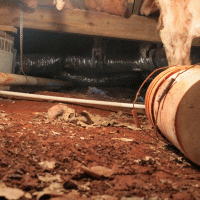The wet, relatively warm weather recently experienced in the southeast has caused a high incidence of mold and other fungal growth complaints in homes and other structures. Engineers at Warren are often called upon to investigate the cause(s) of these problems.
Fungal growths are opportunistic – in that it only requires the right conditions for the problem to flourish. That is because fungal spores are found virtually everywhere in our environment. If the spores encounter a food source, air, favorable temperatures, and a source of moisture, growth will be evident in a few short days.
The control of molds and other fungal growths requires eliminations of one or more of those favorable conditions. The food sources in homes and other building structures is often the building materials, such as the paper backing on sheetrock, adhesives on wallpaper, and structural lumber. Temperatures are maintained at levels for human comfort. Therefore, the most practical means to control the undesirable growth is to reduce moisture content in the structures.
Investigation of these cases generally begins with evaluation of the condition of roofs, flashings, plumbing leaks, and other sources where liquid water may be directly introduced into the building envelope. Oftentimes, however, the problem stems from water vapor in the humid air that is transmitted throughout the structure.
Traditional building practices are beginning to evolve as a means to better control the movement of this moisture. Studies have shown that warm moist air introduced into a ventilated crawl space of a home is problematic. In some cases, a better approach is to seal the crawl space to keep from continually replenishing the crawl space with moisture. In many instances, we have found that the bare earth exposed in a crawl space should be covered with a vapor barrier to slow the transmission of water vapor into the home. We have also seen surface water flowing into crawl spaces when the landscape around the home or building is not properly sloped to drain surface water away; we have also seen shallow subsurface water create wet conditions in crawl spaces, when a French drain around the perimeter would have avoided the problem.
Another traditional building practice in the southeast is the installation of wall or flooring insulation with its vapor retarder closest to the conditioned space. In such cases, when moist air migrates from the crawl space or into perimeter wall cavities in the summertime, it reaches the vapor retarder which has been cooled by the operation of air conditioning, then the air is cooled below its dew point and condensation forms on the vapor retarder surface. The predictable result is heavy fungal growths on subfloors and in wall cavities. The growth also frequently shows up on the painted or papered surfaces of walls. It is preferable to allow that moisture to be transmitted through more permeable perimeter walls into the living area than to condense and be trapped in wall cavities. When the moisture is transmitted into living areas, the air conditioner will remove the excess moisture.
Attention to detail in construction or maintenance can have a large impact on addressing the mold/fungal growth issue. Minimizing or sealing penetrations through the building envelope will prevent introduction of warm moist air into attic spaces where it may condense on cooler surfaces. Avoiding the placement of impermeable wall coverings, such as vinyl-covered wall board, on outside walls will minimize entrapment of moisture in wall cavities. Sealing of wiring, piping, and duct penetrations through top plates of walls will further minimize condensation problems.
Not only are some fungal growths unhealthy, they may eventually cause affect structural members of a home or other building. Identification of the cause will enable you to develop the most effective means of solving the problem.
Warren’s forensic engineering and consulting firm, founded in 1997, provides technical investigations and analysis of personal injury and property claims as well as expert testimony for insurance adjusters and attorneys. Extremely well versed in the disciplines of mechanical, electrical, chemical, structural, accident reconstruction and fire and explosion investigation, our engineers and consultants are known for delivering the truth — origin, cause, responsibility and cost of an event or claim — with unmistakable clarity.




